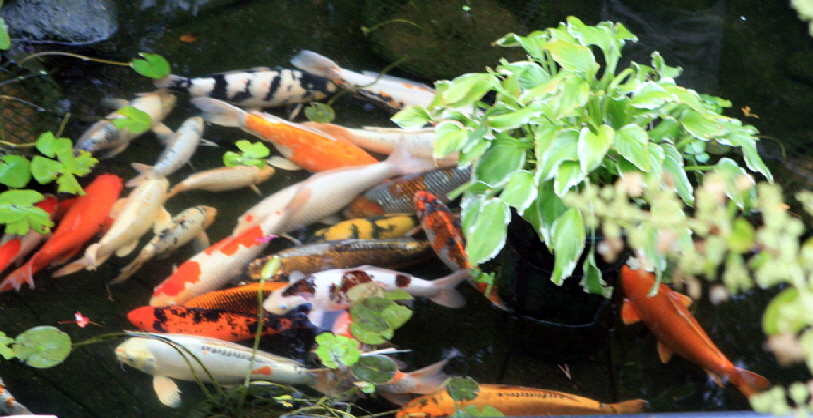|
How many Koi per pond?
Most pond experts say you can have one Koi per 500 gallons. But this is NOT true, The number of koi is dependent on the pond location, size of koi, quality of water and
climate conditions.
Small, shallow ponds can heat and cool fast. Our quarantine tank is a 12 ft intex pool that holds 1800 gallons and is 32 inch deep. It gains 5 degrees per day in summer (even
with a pop up tent over) and cools by 5-10 degrees in spring and fall seasons.
In a pond, fish have to compete with algae, micro-organisms, frogs and bacteria (in the biological filter and the ones working on decomposing matter), as well as plants for
oxygen and minerals. All living things in the pond also excrete toxins and metabolic products like carbon dioxide, ammonia, nitrite and nitrates. These products change the pH, alkalinity and deplete dissolved oxygen. So, one must know
how much oxygen Koi need and how much oxygen can the pond water hold at its highest temperature and worst conditions.
Koi use about 3-5 gm of oxygen per kg body weight per hour while resting. We use about 6 gm of oxygen per kg body weight while resting. While swimming fast or just after
eating or spawning, Koi use up 10 times more oxygen than at rest. Though it seems like Koi use less oxygen than we do, we must remember that water holds only a twentieth of the amount of oxygen that is present in the same volume of air.
If a Koi weighing 1 kg or 2.2 lbs (13-16-inch Koi) needs 50 mg of oxygen per minute at rest, it needs 500 mg of oxygen per minute just after eating or while swimming frantically.
Koi are comfortable when oxygen levels are above 6mg/l. If oxygen levels fall below 3-4mg/l fish begin gasping. Pure water can hold as much as 9 mg/l at 70*F and 7.5 mg/l at
90*F. Suspended particles like pollen, dust and other dissolved contaminants can bring down the levels easily. If you add 0.5% salt, it can decrease oxygen level by 1g/l. Plants and algae use more oxygen than Koi do because their volume
is lot more than Koi.
In a very clean pond, with the help of aerators and waterfalls, one can have 8 mg/l oxygen at 70*F. A 2 lb koi needs 500 mg of oxygen per minute at its highest. We must
provide 62.5 litres or 16.5 gallons of freshly oxygenated water every minute to make this Koi thrive. If the Koi weighs 20lbs, then we need more than 625 litres or 165 gallons of freshly oxygenated water every minute. If you have 4 koi
in a 2000 gallon pond (as it is commonly suggested by pond experts) then the oxygen is depleted in 33 minutes if you do not oxygenate. Time is less if you have algae or plants. So, the pond turnover must be every half hour and you must
have additional aeration.
In other words, if you have 4 adult koi in a 2000 gallon pond, your fish die in less than 30 minutes at 70*F if the pump fails or power goes off. It is more practical to have
enough oxygen for at least 6 hours without any aeration, so that when you return home from work or wake up in the morning, fish are still alive even if there was pump failure.

Let us calculate how quickly the ammonia will be removed in a 2000 gallon pond.
If you have 4 adult koi, each weighing 20 lbs and you feed them 1% of their body weight, you must have filters to remove
ammonia and nitrite as soon as they are produced. If the feed has 40% protein.
363 gm (12.7oz) of pellets will have 145 gm of protein. This is equivalent to 23 gm of Nitrogen. In other words, if fish do
not digest at all, then in a 2000 gallon pond this food will produce 3 ppm Ammonia. If fish can utilize 50% of what they eat, then this will produce 1.5 ppm Ammonia. You must have enough filters to process 3 ppm Ammonia. Because if
temperature goes above 82*F they may not eat. If they do not eat, they will have to combat with high ammonia combined with low oxygen situation.
We know that about 50 litres of K1 Kaldnes media can process 250 gm (8.8oz) of 40% protein feed. You will need
3960 gallons per hour water going through 75 litres (2.65 cu.ft) of K1 Kaldnes media for optimum nitrification of 3 ppm Ammonia. If your pond turnover is every 30 minutes, you can achieve complete nitrification. However, how long does it
take for this 3 ppm Ammonia to become harmless nitrate? Until it is completely converted, Koi have to suffer transient
high ammonia, high nitrite situation. Even if it is 3-4 hours a day, daily exposure to toxins is stressful and will reduce their immunity and growth.
Now, the economics:
To have a 30-minute pond turnover, you need a 4000 gph pump. If you have a 4,000 gallon pond, you can use the same
pump and same number of aerators. The transient ammonia (ammonia present in water before it is converted into nitrite) will only be half as much. The Koi will have more room to swim around. Biggest advantage is that your fish will be
alive for an hour without any aeration, in case of a pump failure!
As you can see, if one has not enough space and/or does not mind taking care of pets full time, raising 4 large fish in a
2000 gallon pond is possible. For the rest of us, 2 large koi or double the size of pond is the solution.
|

